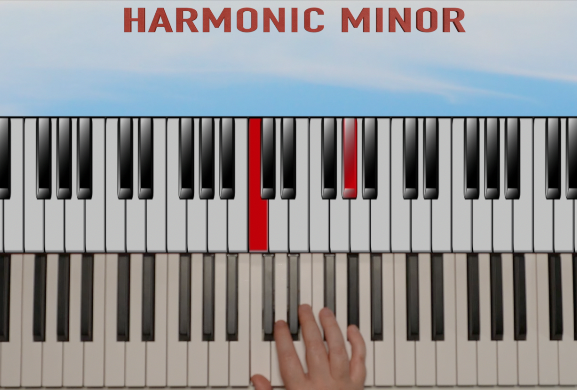
The Harmonic Minor Scale
So far we only worked with the natural minor scale. (Playing it) It’s called natural because it doesn’t contain any altered tones. Those are tones that don’t belong in the scale.
Besides the natural minor we have Harmonic Minor and Melodic minor. On this lesson we’re going to focus on the Harmonic Minor. (Playing it) It’s the same as the natural minor only we raise the seventh degree for a half step up. So instead of this G here we have G#. (PLaying it again).
Now when we raise this seventh degree some of the intervals in the scale will change and get different names. For examle the second between the sixth and the seventh degree which now visually and soundly looks like a minor third will be called an augmented second. Why? Because these two are adjacent degrees and are separated by a step and a half. So it’s still one step something. Therefore it has to be some kind of a second.
Further, the fourth on the seventh degree visually and soundly looks like a major third. But because the lower tone resides on the seventh degree and the upper tone on the third degree, their relationship must be called by some kind of a fourth. So it’s a diminished fourth.
Now what about the fifth on the third degree? How do we call it? Pause the video, think about the answer…Although it looks like a minor sixth we will call it an augmented fifth.
The raised seventh in the harmonic minor scale creates a stronger pull or tension towards the tonic. This tension is often used to create interesting and dramatic harmonies and melodies in music. (Playing a cadence)
Now to get you familiar with the sound of the Harmonic Minor Scale I’ll give you an exercise to play in all keys. Here’s how it goes in C-Minor: (Playing the exercise).
Now I’ll play the exercise for you again slowly so you can learn it. Also i will display the numbering of the fingers so you can know which finger i use with which tone. But that’s not final. You can use your own finger arrangement, however is easier for you. By the way this is the correct numbering of the fingers for piano (Displaying Image). Maybe you’ve seen them in some notation sheets.
After you learn it I want you to analyze it carefully in terms of intervals and scale degrees. See which type of intervals I used for which jump? On what degree? etc…After you understand the relationship between the tones it will be easier for you to play it in differen keys which you will have to do for your homework.
Finger Numbering
Harmonic Minor Homework